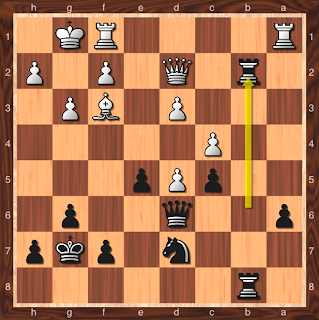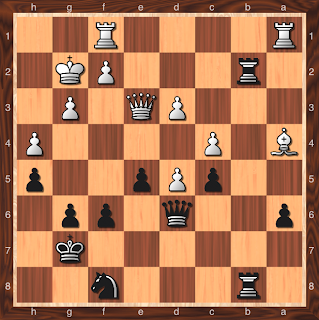Kenilworth Kibitzer
A blog for members of the Kenilworth Chess Club.Saturday, October 19, 2013
Digging through the vault
Fall is upon us, and with it shorter days and less time spent outside. To reinvigorate myself after a lengthy absence from chess, I've decided to go back through my old tournament games, partly for nostalgia but mostly to learn some lessons. Those who do not learn history being doomed to repeat it, etc, etc. Fortunately, there's ~300 tournament games I analyzed over the last 5 years or so, which means no end to the fun. Let's start with #1, back in 2008, in a Westfield Quad against the venerable Leonid Fleysher. We had an odd history, where Black won most of the games we played, and usually only after being in a lost position. If I remember our lifetime record was something like 3-4-3, which means the decisive game is yet to be played....
Leonid Fleysher (1947) - Ian Mangion (1796), Sep 14 2008, Westfield, NJ
1. c4 Nf6
2. Nf3 c5
3. Nc3 e6
4. g3 b6
5. Bg2 Bb7
6. O-O d6
7. d3 g6
8. e4 Bg7
9. a3 a6
10. Rb1 Nc6
Black has offered to play a Queen's Indian, White prefers to play a Botvinnik system English opening. With his last moves White is preparing the thematic b2-b4, which to my ignorant mind is key to the system. With the center virtually locked, breaks on the flank are not only reasonable but necessary. If White delays, Black can prepare ....b7-b5 with the same ideas.
11. b4 O-O (a minor inaccuracy with dour consequences. Now 12. bxc5 dxc5 13. Bg5 Qc7 14. Bf4 leads to an awkward position, which incidentally is basically seen later in the game. 11....Nd7 is stronger, hitting the knight on c3 and allowing recapture on c5 with the knight on d7)
12. Bg5 Qc7
13. Qd2 Nd4
14. bxc5
Leonid Fleysher (1947) - Ian Mangion (1796), Sep 14 2008, Westfield, NJ
1. c4 Nf6
2. Nf3 c5
3. Nc3 e6
4. g3 b6
5. Bg2 Bb7
6. O-O d6
7. d3 g6
8. e4 Bg7
9. a3 a6
10. Rb1 Nc6
Black has offered to play a Queen's Indian, White prefers to play a Botvinnik system English opening. With his last moves White is preparing the thematic b2-b4, which to my ignorant mind is key to the system. With the center virtually locked, breaks on the flank are not only reasonable but necessary. If White delays, Black can prepare ....b7-b5 with the same ideas.
11. b4 O-O (a minor inaccuracy with dour consequences. Now 12. bxc5 dxc5 13. Bg5 Qc7 14. Bf4 leads to an awkward position, which incidentally is basically seen later in the game. 11....Nd7 is stronger, hitting the knight on c3 and allowing recapture on c5 with the knight on d7)
12. Bg5 Qc7
13. Qd2 Nd4
14. bxc5
14.... Nxf3+ ?! (hard to imagine what compelled me to play this. these days I would play ...bxc5 almost without thinking. perhaps I was trying to simplify, but really Black's knight is better)
15. Bxf3 dxc5 (now ...bxc5 can be met by the vexing 16. Bxf6! Bxf6 17. e5!)
16. Bf4 e5
17. Be3 Nd7
18. Nd5
Now Black's position is unpleasant, to say the least. His only active play can come from breaks on the b or f-file, but with White's dominance in the center, such play is likely to end poorly. My mind already drifted toward defeat at this point.
18...... Bxd5
19. exd5 Qd6
20. Bh6 ?! Rab8
21. Bxg7 Kxg7
22. a4 Rb7
White made the curious decision to get rid of his bishop pair, exchanging his 'good' bishop for Black's lemon on g7. White's protected passed pawn on d5 promises an advantage, but now Black has latched on to a clear strategy of cracking open the b-file. ...f5 could follow as well
23. a5? Rfb8?
Favors for favors. 23. Rb2 was much stronger, preparing to oppose Black's doubled rooks with his own doubled rooks. But then Black misses the big chance - ....b5! For what else was he putting his rooks on this file? Surely not just to trade them off, endgames for Black promise passive defense.
24. axb6 Rxb6
25. Ra1?! Rb2
Why does White avoid the trade of rooks? Only Black can benefit from tactical continuations. Now Black dreams of doubling his rooks on the 7th rank. Remarkably, he even manages to achieve this, albeit with some help. White's position is still preferable, but he has opened up the possibility of all three results.
26. Qe3 f6 (...f5!?)
27. h4 h5
28. Kg2 Rc2? (dreaming of doubling the rooks, but White cleverly latches onto the chance to awaken his dead bishop)
29. Bd1! Rcb2
30. Ba4 Nf8
Ugh. ...Nf8 was forced, both tactically (the a-pawn) but also positionally - the position with queens and rooks only must be a win for White. As it is, with his bishop outside the pawn chain and terrorizing Black's back ranks, White has a decisive positional advantage.
31. Bc6 R8b6
32. Ra5?
I was in time trouble by this point, and this on the rickety old wind-up clocks once so prevalent at Westfield. However, by good fortune I had stayed awake to tactical possibilities - after all, this is all I could hope for. How could I get my knight back in the game?
32. .... Ne6!
Exposing the subtle fault in the bishop laced on c6 - it is defended only by the passed pawn on d5! That pawn can now take my knight, but....at the price of the bishop, and then its own life. White still has a reasonable position, but Black now has active threats, and the sudden change in the momentum provoked my opponent into further mistakes. A common phenomenon!
33. Rfa1 Nd4 (remarkably, a Black knight once again sits on d4, as part of its journey from g8-f6-d7-f8-e6-d4)
34. Ba4 ?? Re2! (even more remarkably, Black achieves his long held dream of doubling his rooks on the 7th rank. This is one bridge too far for White. Despite my time trouble, I smashed White's position with poise that was very rare for me at that time)
35. Qc1 Rbb2
36. Qf1 Nf5
37. Kf3
37. ..... e4+!
38. dxe3 Re3+! (I had my Wheaties that morning, clearly)
39. fxe3?! Qxg3 mate
And so....a game played with indifferent skill by Black, saved only by a remote tactical opportunity in what should have been a lost position. Such is amateur chess! But we'll see many, many examples where I'm on the receiving end of bad fortune.
Archives
February 2009 March 2009 April 2009 May 2009 June 2009 July 2009 August 2009 September 2009 October 2009 November 2009 December 2009 January 2010 February 2010 March 2010 April 2010 May 2010 June 2010 July 2010 August 2010 September 2010 October 2010 November 2010 December 2010 January 2011 February 2011 March 2011 April 2011 May 2011 June 2011 January 2012 February 2012 March 2012 May 2012 July 2012 December 2012 January 2013 February 2013 July 2013 October 2013 March 2014
Subscribe to Comments [Atom]







Post a Comment